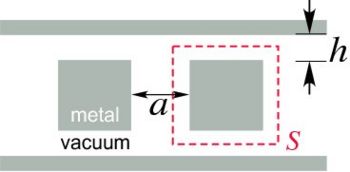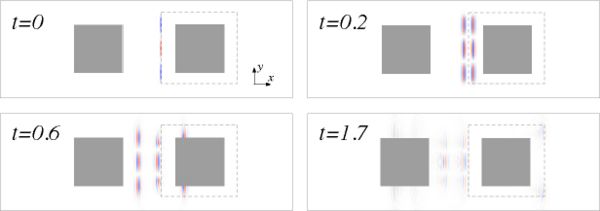Casimir calculations in Meep
From AbInitio
(diff) ←Older revision | Current revision | Newer revision→ (diff)
| Meep |
| Download |
| Release notes |
| FAQ |
| Meep manual |
| Introduction |
| Installation |
| Tutorial |
| Reference |
| C++ Tutorial |
| C++ Reference |
| Acknowledgements |
| License and Copyright |
Casimir calculations in Meep
It is possible to use the Meep time-domain simulation code in order to calculate Casimir forces (and related quantities), a quantum-mechanical force that can arise even between neutral bodies due to quantum vacuum fluctuations in the electromagnetic field, or equivalently as a result of geometry dependence in the quantum vacuum energy.
Calculating Casimir forces in a classical time-domain Maxwell simulation like Meep is possible because of a new algorithm described in:
- Alejandro W. Rodriguez, Alexander P. McCauley, John D. Joannopoulos, and Steven G. Johnson, "Casimir forces in the time domain: I. Theory," arXiv preprint archive article arXiv:0904.0267 (April 2009).
- Alexander P. McCauley, Alejandro W. Rodriguez, John D. Joannopoulos, and Steven G. Johnson, "Casimir forces in the time domain: II. Applications," arXiv preprint archive article arXiv:0906.5170 (June 2009).
This page will provide some tutorial examples showing how these calculations are performed for simple geometries.
Introduction
In this section, we introduce the equations and basic considerations involved in computing the force using the method presented in Rodriguez et. al. (arXiv:0904.0267). Note that we keep the details of the derivation to a minimum and instead focus on the calculational aspects of the resulting algorithm.
The basic steps involved in computing the Casimir force are:
1. Surround the object for which the force is to be computed with a simple, closed surface S. It is often convenient to make S a rectangle in two dimensions and a rectangular prism in three dimensions.
2. Add a uniform, frequency-independent conductivity σ to the dielectric response of every object (which is easily done Meep). The purpose of this is to rapidly reduces the time required for the simulations below.
3. Measure the electric E and magnetic H fields on S in response to a set of different current distributions on S (more on the specific form of these currents later).
4. Integrate these fields over the enclosing surface S at each time step, and then integrate this result, multiplied by a known function g( − t), over time t.
The Casimir force is given by an expression of the form:

where Γij;n are the fields in response to sources related to the functions fn (discussed in detail later), S is an arbitrary closed surface enclosing the object for which we want to compute the Casimir force, g(t) is a known function, and the index n ranges over all of the integers.
<ref>Note that the precise implementation of step (3) will greatly affect the efficiency of the method. For example, computing the fields due to each source at each point on the surface separately requires a separate Meep calculation for each source (and polarization). As described in <ref name="Rodriguez"/>, and further below, it is possible to modify these steps in order to optimize the calculation of the stress tensor over the spatial surface. For the purpose of this introduction, however, we do not require specific details on how we handle the spatial integration.</ref>
Example: two-dimensional blocks
In this section we calculate the Casimir force in the two-dimensional double-block configuration (Rodriguez et. al, Physical Review Letters, vol 99, p 080401 2007) shown below:
The dashed red lines indicate the surface S. This system consists of two metal  squares in between metallic sidewalls. As described in Part II, the first step is to add a uniform, frequency-independent D-conductivity σ to all the dielectrics (in this case metal and vacuum):
squares in between metallic sidewalls. As described in Part II, the first step is to add a uniform, frequency-independent D-conductivity σ to all the dielectrics (in this case metal and vacuum):
(define-param Sigma 1) (define my-metal (make material (epsilon -1e20) (D-conductivity Sigma))) (define my-air (make material (epsilon -1e20) (D-conductivity Sigma))) (set! default-material my-air)
We then add in the double blocks:
(set! geometry
(list (make block (center a 0) (size a a infinity) (material my-metal))
(make block (center (- a) 0) (size a a infinity) (material my-metal))))
As discussed in Part I, the optimal value of σ depends on the system under consideration. In our case, σ = 1 appears to be optimal or near optimal.
In the ideal system the empty space extends to infinity in both the left and right directions. For a finite computational cell, we define a horizontal buffer region xbuffer and impose periodic boundary conditions in x and metallic boundary conditions in y:
(set! geometry-lattice (make lattice (size (+ (* 3 a) (* 2 xbuffer)) (+ a (* 2 h)) no-size)))
When imposing the boundary conditions, it is important to first initialize the fields in Meep:
(init-fields) (meep-fields-use-bloch X 0)
Note that this is different from (set! k-point (vector3 0)) as this will assign periodic boundary conditions to both x and y.
We then define the surface S through lists containing the centers and sizes of each side of S:
(define block-cen (vector3 a 0 0)) (define xshift (vector3 (/ L 2) 0 )) (define yshift (vector3 0 (/ L 2)))
(define face-centers
(list (vector3- block-cen xshift) (vector3+ block-cen xshift)
(vector3- block-cen yshift) (vector3+ block-cen yshift)))
(define face-sizes
(list (vector3 0 L) (vector3 0 L) (vector3 L 0) (vector3 L 0)))
This contains all the information about S and can be used for many two-dimensional Casimir force calculations.
As described in Part II, the next step is to pick a basis of functions {fn} on S, indexed by n, such that these form a complete and orthonormal basis for all real-valued functions on S. Since S consists of four distinct line segments, we take a real cosine basis:

where L is the side length (if each side has a different length, then the functions fn(x) will differ for each side). An illustration of these functions for the system under consideration is shown below:
These functions fn(x) are easily defined in the ctl file:
(define (dct X n source-size)
(let*
((X-start (vector3+ X (vector3-scape 0.5 face-size))))
(x (vector3-x X-start))
(y (vector3-y X-start))
(kx (/ (* n pi) L))
(ky (/ (* n pi) L)))
(* (sqrt (/ 2 L)) (cos (* kx x)) (cos (* ky y))))
The reason for the shift from X to X-start is that the origin of the dct functions is the endpoint of the line segment, while the origin for a function (amp-func ...) is taken to be the center of the surface.
A simulation is run for each n, each side of S, indexed by the integer side, and each source polarization. The source itself has the form:

This is defined using the custom-src function:
(change-sources!
(list (make source
(src (make custom-src
(src-func (lambda (t) (if (= t (* 1.5 dt)) (/ 1 dt) 0)
(is-integrated? false) (start-time (- infinity)) (end-time 1)))
(center (list-ref face-centers side)) (size (list-ref face-sizes side))
(component current-pol) (amplitude 1)
(amp-func (lambda (X) (dct X n (list-ref face-sizes side))))))
where dt is the unit of time-stepping given by (meep-fields-dt-get fields).
To illustrate the field profiles, below we show four snapshots at different times for what we term  , the y-component of the electric field response to a y-polarized current source with spatial dependence f2(x)
, the y-component of the electric field response to a y-polarized current source with spatial dependence f2(x)
At each time-step, the fields are integrated over S weighted by




